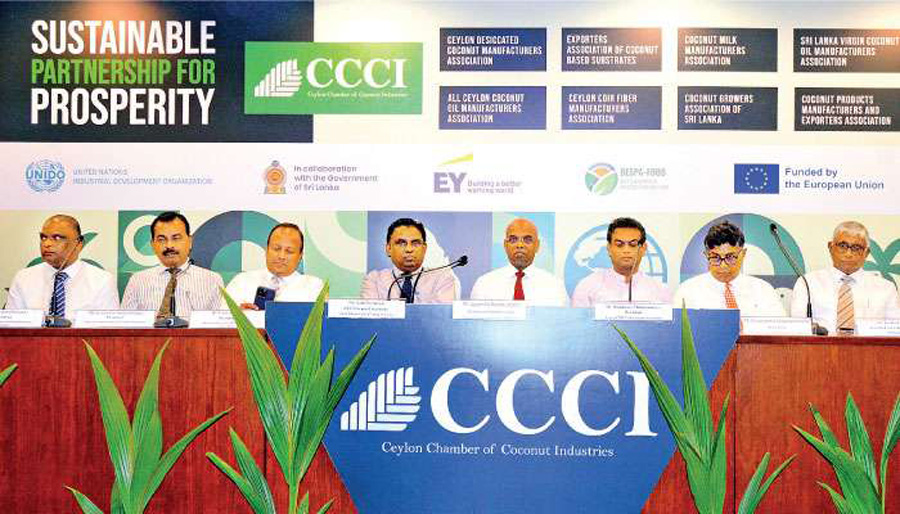The launch of the Northern coconut triangle under the Kapruka Saviya programme, initiated by His Excellency the President Anura Kumara Dissanayake, is a step towards unlocking the full potential of the coconut industry and uplifting rural livelihoods in the northern province of Sri Lanka.
The Ceylon Chamber of Coconut Industries (CCCI) recognises this initiative as a landmark development for the sector and the communities it supports.
The coconut has long been called Sri Lanka’s “tree of life.”
It feeds our families, sustains rural communities, and supports a wide range of industries from food to fiber.
Yet, the demands of global markets and the realities of climate and economic change mean the industry must evolve.
The Northern coconut triangle represents that shift moving beyond tradition into a future of scale, innovation, and inclusion.
Replanting prosperity
Over the next few years, Sri Lanka will bring tens of thousands of new hectares into coconut cultivation, especially across Jaffna, Mullaitivu, and Mannar.
This expansion is not just about land; it is about strengthening farmer communities, raising awareness, and creating pathways for rural entrepreneurship.
Several key interventions will drive this transformation:
• Expanding farmland for coconut plantations to boost national output.
• Supporting farmer communities to sustain livelihoods and enhance resilience.
• Raising awareness on the importance of the coconut industry for national prosperity.
• Providing entrepreneurship opportunities and targeted support for rural farmers.
• Lifting productivity from 2.7 billion nuts in 2024 to 2.9 billion in 2025, and setting a trajectory to reach 4.2 billion by 2030.
• Developing coconut-based SMEs in the North and East to add value closer to plantations.
• Increasing yields by 10 -15% annually, a crucial step to achieve Sri Lanka’s 2030 export target of USD 2.5 billion, more than doubling today’s USD 1 billion.
Governance, innovation, and global positioning
The Kapruka Saviya programme is not only about cultivation.
It also introduces modern governance and market tools to future-proof the sector.
Through partnerships with the United Nations Industrial Development Organization (UNIDO) and Regen Agri, farmers will gain access to good governance practices, sustainability frameworks, and regenerative agriculture techniques.
These initiatives will help strengthen compliance, improve productivity, and open pathways to premium markets.
Equally important is the geo-identification of products.
By creating GI-based certification for Sri Lankan coconut products, exporters will be able to calculate stronger market formulae, secure international recognition, and carve out a premium position for Sri Lankan coconut on the global stage.
Why the North matters
The Northern Province, with its abundance of agricultural land and farming communities who have supported Sri Lanka’s food chain for decades, represents the next gateway of agripreneurial growth.
By expanding coconut cultivation and value-added industries in the North, Sri Lanka can simultaneously boost exports, strengthen food security, and create long-term opportunities for rural communities and could have positive GDP impact for Sri Lanka, says Ranil De Saram CCCI Secretary General and Senior Partner at EY Sri Lanka.
This region is also suited for multi-crop agriculture, offering synergies with other crops and strengthening the resilience of farmers.
With the right support, the North can become both a hub for coconut production and a model for diversified, sustainable agriculture.
Industry alignment and support
The CCCI brings together the strength of its eight founding member associations: Coconut Growers Association of Sri Lanka, Exporters Association of Coconut Based Substrates, Sri Lanka Virgin Coconut Oil Manufacturers Association, Coconut Product Manufacturers and Exporters Association, Ceylon Desiccated Coconut Manufacturers Association, Ceylon Coir Fiber Manufacturers Association, Coconut Milk Manufacturers Association, All Ceylon Coconut Oil Manufacturers Association supported by UNIDO, the BESPA food program of the European Union and Ernst & Young(EY) the accounting and consultancy firm forms a pivotal base to support strong industrial and economic activity to promote the coconut industry development to new heights.
The CCCI views the development of the northern coconut triangle as the next waive of Sri Lanka’s economic growth trajectory.
CCCI president Jayantha Samarakoon is of the view that these associations represent the collective expertise and reach of the entire coconut value chain from growers to exporters and processors.
This united approach ensures that growth is not fragmented but shared, strengthening the sector’s ability to deliver on both domestic and export ambitions.
Looking ahead
The Northern Coconut Triangle is more than a geographic expansion; it is a statement of intent.
It signals that Sri Lanka sees the coconut not only as a cultural icon but as a strategic driver of economic renewal.
By combining sustainable practices, regenerative agriculture, GI-based branding, farmer empowerment, and bold export goals, Sri Lanka can transform how the world views its coconut products.
By 2030, if we achieve the targets set — increasing production to 4.2 billion nuts and export income to USD 2.5 billion the coconut will have moved firmly from being the “tree of life” to becoming a true engine of national growth.
On this World Coconut Day, we celebrate not just the coconut itself, but the determination to reimagine its future.
The Kapruka Saviya programme and the creation of the Northern Coconut Triangle offer a pathway to resilience, innovation, and prosperity for Sri Lanka’s coconut sector.
It is now up to all of us farmers, industry leaders, policymakers, and consumers to rally behind this vision.
If we succeed, the humble coconut will continue to nourish our people, strengthen our economy, and stand tall as a symbol of Sri Lanka’s progress in the decades ahead.






















